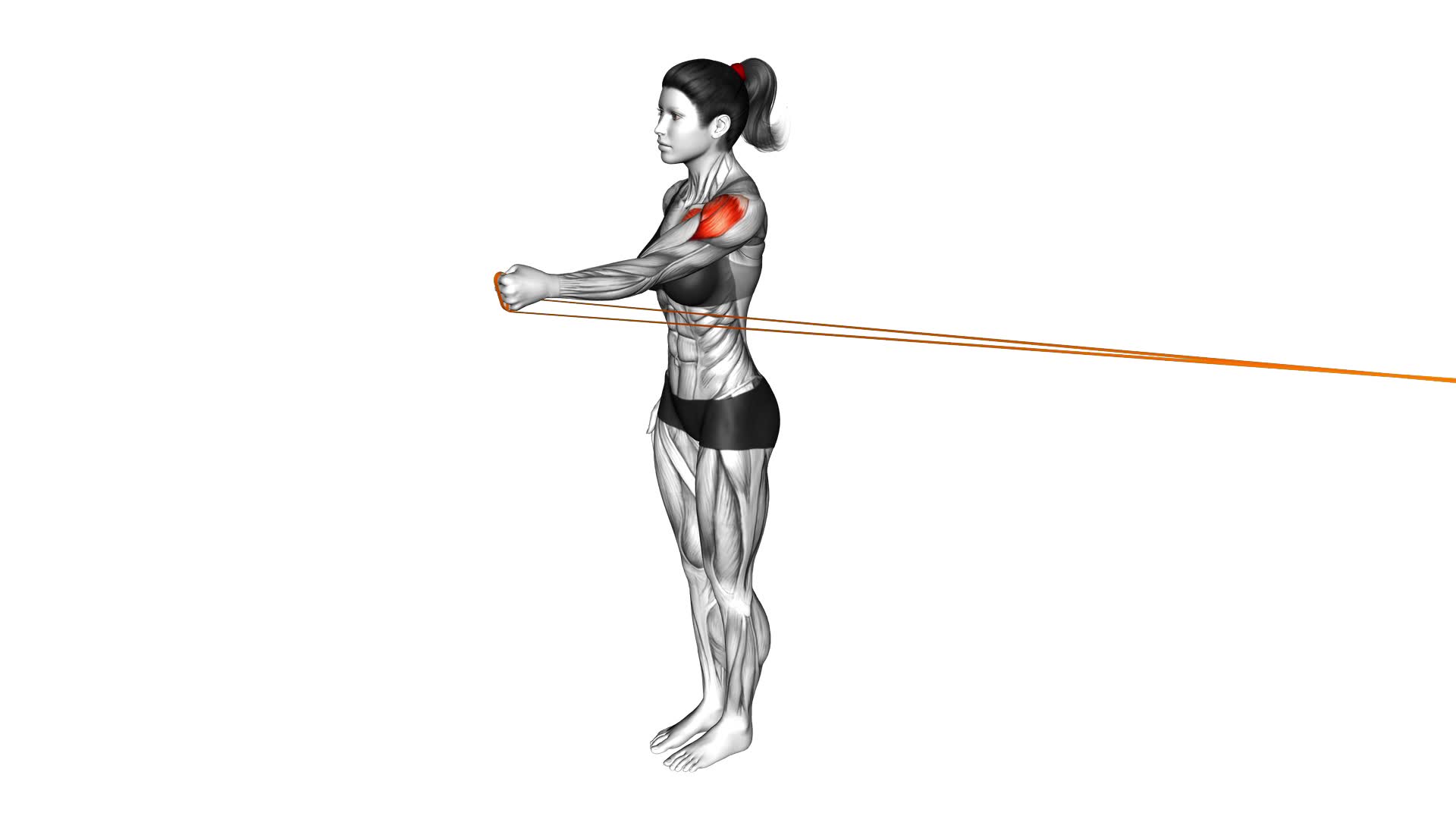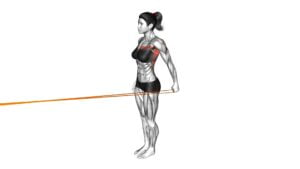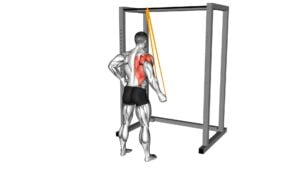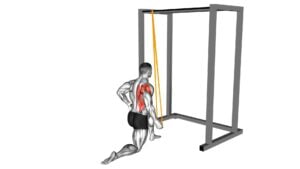Resistance Band Standing Single Arm Shoulder Flexion (female) – Video Exercise Guide & Tips

Looking to strengthen and tone your shoulders? In this video exercise guide, we'll show you how to perform the resistance band standing single arm shoulder flexion.
Watch This Exercise Video
This exercise targets your deltoids, helping you build strength and improve shoulder mobility.
With proper form and technique, you can maximize the benefits of this workout.
Watch the video and follow our tips to ensure you're using the right resistance band and avoiding common mistakes.
Get ready to take your shoulder workout to the next level!
Key Takeaways
- Resistance band shoulder flexion targets deltoids for strength and mobility.
- This exercise increases muscle activation in the upper body.
- It helps develop stronger and defined shoulder muscles.
- Resistance band shoulder flexion improves flexibility and range of motion in the shoulders.
Benefits of Resistance Band Shoulder Flexion
To fully grasp the benefits of resistance band shoulder flexion, it's important to understand how this exercise can improve your upper body strength and flexibility. When performing resistance band shoulder flexion, the band tension provides resistance that targets the muscles in your shoulders, specifically the deltoids. This increased tension not only helps to strengthen these muscles but also promotes muscle activation throughout your upper body. By consistently performing this exercise, you can develop stronger and more defined shoulder muscles.
Resistance band shoulder flexion also helps to improve your flexibility. As you raise your arms overhead against the band tension, you're stretching the muscles in your shoulders and upper back. This stretching motion helps to increase your range of motion, allowing you to move more freely and perform other exercises with greater ease.
In addition to the physical benefits, resistance band shoulder flexion is a convenient and portable exercise that can be done anywhere. Whether you're at home, in the gym, or traveling, all you need is a resistance band to engage your shoulder muscles and reap the benefits of this exercise.
With an understanding of the benefits of resistance band shoulder flexion, it's now important to focus on proper form and technique to maximize your results.
Proper Form and Technique
Position your feet shoulder-width apart and grasp the resistance band with your hand. To perform the proper form and technique for the resistance band standing single arm shoulder flexion exercise, follow these steps:
- Stand tall with your core engaged and shoulders relaxed.
- Hold the resistance band in your hand with your palm facing down and your arm extended in front of you.
- Slowly raise your arm, keeping it straight, until it's parallel to the floor.
- Pause for a moment and then slowly lower your arm back to the starting position.
Maintaining proper form and technique during the resistance band standing single arm shoulder flexion exercise is important for several reasons. Firstly, it helps to maximize the benefits of shoulder flexion, which include strengthening the muscles of the shoulder, improving shoulder stability, and increasing range of motion.
Additionally, proper shoulder alignment is crucial to prevent injury and ensure that the exercise targets the intended muscles effectively. By positioning your feet shoulder-width apart and maintaining a stable core, you can enhance shoulder alignment and minimize the risk of strain or discomfort.
Remember to perform the exercise in a controlled manner, focusing on the contraction of the shoulder muscles throughout the movement.
Choosing the Right Resistance Band
When choosing the right resistance band for your workout, there are a few key points to consider.
First, determine the band strength level that best suits your current fitness level and goals.
Next, consider the material options available, such as latex or fabric bands, and choose one that fits your preferences and needs.
Lastly, think about the band length, as different exercises may require different lengths for optimal performance.
Band Strength Levels
Choose the appropriate resistance band for your single arm shoulder flexion exercise by considering the band strength levels available. When selecting a resistance band, it's important to choose one that provides enough resistance to challenge your muscles without causing strain or discomfort.
Here are three band strength levels to consider:
- Light: This level is ideal for beginners or those recovering from an injury. It offers the least amount of resistance and is suitable for people with limited strength or mobility.
- Medium: This level provides moderate resistance and is suitable for individuals who've some experience with resistance band exercises. It offers a good balance between challenging the muscles and maintaining proper form.
- Heavy: This level offers the highest amount of resistance and is suitable for advanced users or those looking to increase their strength and endurance. It provides a greater challenge to the muscles and can help promote muscle growth and development.
Band Material Options
To ensure optimal resistance and comfort during your single arm shoulder flexion exercise, consider the different band material options available. When it comes to resistance bands, there are several material types to choose from.
The most common ones include latex, rubber, and fabric. Latex bands are known for their durability and elasticity, making them ideal for resistance training. Rubber bands offer similar benefits and are often used for strength and flexibility exercises. Fabric bands, on the other hand, are made of a soft and stretchy material, providing a more comfortable feel against the skin.
Regardless of the material you choose, resistance band training offers numerous benefits such as improved strength, flexibility, and muscle tone. So, select the band material that suits your needs and get ready to enhance your workout routine.
Band Length Considerations
To ensure you have the right resistance band for your single arm shoulder flexion exercise, consider the length of the band. The band size plays a crucial role in the effectiveness and safety of your resistance band exercises.
Here are three factors to consider when choosing the right band length:
- Arm length: Measure the distance from your shoulder to your hand. This will give you an idea of the band length you need to achieve a full range of motion during the exercise.
- Exercise intensity: Depending on your strength and fitness level, you may need a longer or shorter band to provide the desired resistance. A longer band offers less tension, while a shorter band offers more resistance.
- Exercise variation: If you plan to perform different resistance band exercises, it's beneficial to have bands of different lengths. This allows you to adjust the resistance level according to the specific exercise.
Variations and Modifications
Your variations and modifications for the Resistance Band Standing Single Arm Shoulder Flexion exercise will help you personalize your workout and target specific areas of your shoulder muscles. There are several ways you can modify this exercise to suit your needs and fitness level.
One variation is to change the resistance band's tension by selecting a band with more or less resistance. Using a band with higher resistance will make the exercise more challenging, while using a band with lower resistance will make it easier.
Another modification you can make is to vary the grip position. Instead of holding the band with an overhand grip, try using an underhand grip or a neutral grip. This will engage different muscles in your shoulder and provide a different stimulus.
Additionally, you can experiment with different arm positions. Instead of raising your arm directly in front of you, you can try raising it slightly to the side or diagonally. This will target different areas of your shoulder muscles.
Remember to listen to your body and choose variations and modifications that feel comfortable and effective for you. By personalizing the exercise, you can optimize your shoulder muscle development and prevent boredom in your workout routine.
Now, let's move on to the next section and discuss common mistakes to avoid.
Common Mistakes to Avoid
Avoid these common mistakes when performing the Resistance Band Standing Single Arm Shoulder Flexion exercise to ensure proper form and maximize its benefits.
Maintaining good shoulder flexibility is essential for overall upper body strength and range of motion. By avoiding these mistakes, you can ensure that you're getting the most out of your shoulder workout:
- Using too heavy of a resistance band: It's important to choose a resistance band that allows you to perform the exercise with proper form. Using a band that's too heavy can lead to poor technique and increase the risk of injury.
- Rounding your shoulders: Keep your shoulders back and down throughout the exercise. Avoid rounding your shoulders forward, as this can put unnecessary strain on your neck and upper back.
- Not engaging your core: To maintain stability and proper posture, engage your core muscles throughout the exercise. This will help to support your spine and prevent any excessive arching or leaning.
By avoiding these common mistakes, you can ensure that you're performing the Resistance Band Standing Single Arm Shoulder Flexion exercise correctly and effectively.
Now, let's move on to the next section for tips on maximizing your shoulder workout.
Tips for Maximizing Your Shoulder Workout
To maximize your shoulder workout, it's essential to focus on proper form and technique. This means maintaining the correct posture and alignment throughout the exercises.
Additionally, ensure that you're achieving a full range of motion in your shoulder movements to engage all the muscles effectively.
Lastly, gradually progress and vary your workouts to challenge your shoulder muscles and continue making progress.
Proper Form and Technique
For optimal results during your shoulder workout, it's important to maintain proper form and technique. Here are three tips to help you maximize your shoulder workout, while also preventing injuries and activating the right muscles:
- Maintain a neutral spine: Stand tall with your shoulders back and down, avoiding any excessive arching or rounding of your back. This will help distribute the load evenly and reduce the risk of strain or injury.
- Engage your core: Squeeze your abdominal muscles throughout the exercise to provide stability and support to your spine. This will also help transfer power from your lower body to your upper body, maximizing the effectiveness of the exercise.
- Control the movement: Avoid using momentum or swinging your arm. Instead, focus on a slow and controlled motion, emphasizing the contraction of your shoulder muscles throughout the exercise.
By following these tips, you'll ensure proper form and technique, leading to a safer and more effective shoulder workout.
Transitioning into the next section, let's now discuss the importance of range of motion in your shoulder exercises.
Range of Motion
To maximize your shoulder workout and achieve optimal results, focus on maximizing your range of motion. Increasing flexibility and shoulder mobility are key factors in maximizing your shoulder workout.
When performing exercises such as the Resistance Band Standing Single Arm Shoulder Flexion, it's important to ensure that you're able to move your shoulder joint through its full range of motion. This not only helps to strengthen the muscles surrounding the shoulder, but also improves overall shoulder function and reduces the risk of injury.
To increase flexibility and shoulder mobility, incorporate exercises that target the muscles surrounding the shoulder joint, such as stretches, rotations, and mobility exercises. By consistently working on improving your range of motion, you can enhance the effectiveness of your shoulder workout and achieve better results.
Gradual Progression and Variation
Start by gradually increasing the resistance and incorporating different exercises to vary your shoulder workout. Gradual progression is key to improving your shoulder strength and preventing injury. Here are some tips for maximizing your shoulder workout:
- Increase the resistance: As you become comfortable with a certain level of resistance, gradually increase it to challenge your muscles and continue making progress.
- Vary your exercises: Perform a variety of shoulder exercises, such as shoulder presses, lateral raises, and front raises, to target different muscles and prevent plateauing.
- Adjust exercise intensity: Modify the number of repetitions and sets, as well as the rest periods between exercises, to adjust the intensity of your workout and keep your muscles guessing.
Frequently Asked Questions
How Many Repetitions Should I Do for the Resistance Band Standing Single Arm Shoulder Flexion Exercise?
For the resistance band standing single arm shoulder flexion exercise, it's recommended to perform a repetition range of 8 to 12 reps. This will help effectively activate and strengthen your shoulder muscles.
Start with a weight that challenges you but allows you to maintain proper form throughout the exercise. Gradually increase the resistance as you become stronger.
Remember to listen to your body and adjust the repetitions and weight accordingly to avoid overexertion or injury.
Can I Use Dumbbells Instead of a Resistance Band for This Exercise?
Yes, you can use dumbbells instead of a resistance band for this exercise. However, using resistance bands offers several benefits over dumbbells.
Resistance bands provide variable resistance throughout the entire range of motion, helping to strengthen and stabilize your shoulder muscles more effectively. They also allow for greater control and precision in targeting specific muscle groups.
Is It Necessary to Warm up Before Performing the Resistance Band Standing Single Arm Shoulder Flexion Exercise?
Before performing the resistance band standing single arm shoulder flexion exercise, it's necessary to warm up.
Incorporating warm-up exercises before resistance band training has several benefits. It helps increase blood flow to the muscles, improves flexibility and range of motion, and reduces the risk of injury.
Additionally, warming up prepares your body for the workout ahead and enhances overall performance.
Modifications and variations of the exercise can be made to suit individual needs and goals.
Can This Exercise Help in Improving Posture?
Improving your posture is important for overall health and appearance.
Shoulder exercises, like the resistance band standing single arm shoulder flexion, can help you achieve better posture. By strengthening your shoulder muscles, you can improve your upper body alignment and reduce slouching.
This exercise specifically targets the muscles responsible for proper shoulder movement and stability, which can have a positive impact on your posture.
Incorporating shoulder exercises into your routine can provide numerous benefits for your overall posture.
Are There Any Specific Precautions or Contraindications for This Exercise?
When performing the Resistance Band Standing Single Arm Shoulder Flexion exercise, it's important to be aware of any precautions or contraindications.
Before starting, make sure you have no shoulder injuries or pain. If you do, consult with a healthcare professional before attempting this exercise.
Additionally, if you experience any discomfort or pain during the exercise, stop immediately and seek medical advice.
Always listen to your body and stay safe while working out.
Conclusion
In conclusion, resistance band standing single arm shoulder flexion is a beneficial exercise for strengthening and toning the shoulders. By using the proper form and technique, along with choosing the right resistance band, you can maximize the effectiveness of this exercise.
It's important to avoid common mistakes and consider variations and modifications to suit your fitness level. Incorporating these tips into your shoulder workout routine can help you achieve your fitness goals.

Author
Years ago, the spark of my life’s passion ignited in my mind the moment I stepped into the local gym for the first time. The inaugural bead of perspiration, the initial endeavor, the very first surge of endorphins, and a sense of pride that washed over me post-workout marked the beginning of my deep-seated interest in strength sports, fitness, and sports nutrition. This very curiosity blossomed rapidly into a profound fascination, propelling me to earn a Master’s degree in Physical Education from the Academy of Physical Education in Krakow, followed by a Sports Manager diploma from the Jagiellonian University. My journey of growth led me to gain more specialized qualifications, such as being a certified personal trainer with a focus on sports dietetics, a lifeguard, and an instructor for wellness and corrective gymnastics. Theoretical knowledge paired seamlessly with practical experience, reinforcing my belief that the transformation of individuals under my guidance was also a reflection of my personal growth. This belief holds true even today. Each day, I strive to push the boundaries and explore new realms. These realms gently elevate me to greater heights. The unique combination of passion for my field and the continuous quest for growth fuels my drive to break new ground.







